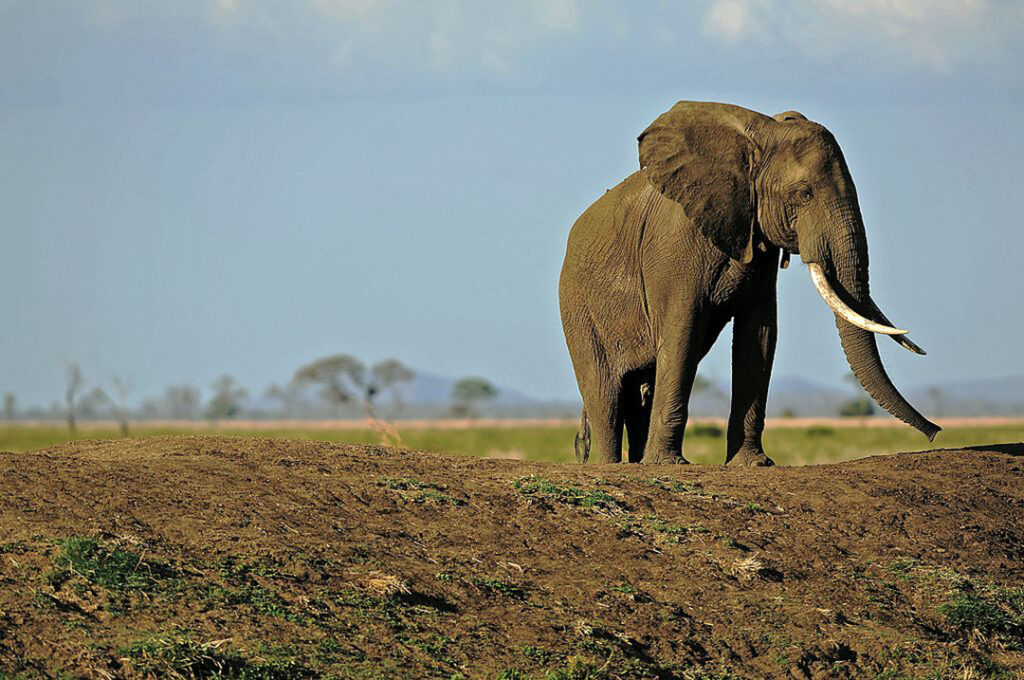ADF STAFF
Once known as a killing field for Africa’s elephants, Tanzania has seen its elephant population grow substantially in recent years thanks in part to better protection against poaching and restrictions of illegal ivory sales.
Maurus Msuha, director of wildlife in the Ministry of Natural Resources and Tourism, told the environmental group Oxpeckers International that militarizing anti-poaching operations and creating other systems to confront poachers has driven the change.
“Therefore, we are good in the protection of wildlife,” Msuha said.
Recent estimates of Tanzania’s elephant population show that it has grown by nearly 40% to more than 60,000 animals over the past five years. The Tanzania Wildlife Research Institute conducts aerial surveys of the country’s large animals to track population changes.
The recent success in expanding Tanzania’s elephant herds stands in sharp contrast to the period between 2009 and 2014. Conservation groups said that in those years poaching occurred on an “industrial scale.”
During that period, government reports showed that the elephant population dropped by 60%, which is about 60,000 animals.
In 2014, the government created the Tanzania Wildlife Management Authority to drive the country’s anti-poaching efforts. The authority’s teams patrol in and around Tanzania’s wildlife reserves and run interdiction efforts at Julius Nyerere International Airport and at the seaport in Dar es Salam.
According to a review of prosecutions by Oxpeckers and InfoNile, seizures of illegal animal products in Tanzania peaked in 2015 when authorities intercepted more than 1,100 elephant parts. Since then, poaching and trafficking of animal parts has declined sharply. In 2021, the government reported 69 seizures. So far this year, the number is 22.
Francis Konde, acting head of Katavi National Park in western Tanzania, said anti-poaching teams have taken a more aggressive approach to violators in recent years.
“We often arrest and bring them to justice so that the law takes it course,” Konde told Oxpeckers. “But we urge the people to stop such acts as we are well-prepared, and anyone who enters the park for criminal acts will be arrested and taken to court.”
In their research, Oxpeckers and InfoNile recorded nearly 400 arrests, seizures, court cases, and convictions for trafficking in elephant ivory and other animal parts over the past five years. The data is reported online as part of the groups’ #WildEye East Africa project.
In 2015, Tanzania’s crackdown on poaching netted one of the country’s most notorious traffickers, Chinese national Yang Fenglan, also known as the Ivory Queen.
In 2019, Fenglan and two Tanzanian men were sentenced to 15 years in prison for smuggling more than 850 elephant tusks worth nearly $6.5 million out of the country. They got an additional two years for violating Tanzania’s Wildlife Protection Act.
They lost an appeal in 2020 and remain in prison.
Fenglan’s arrest was a reminder of the role international cartels play in the trafficking of Africa’s wildlife. Such operations can be difficult to break up even when members are caught and sentenced to prison, according to Didi Wamukoya, director of the African Wildlife Foundation’s counter-wildlife trafficking program.
“It is difficult to identify and disrupt trafficking rings due to the transnational nature of their operations and the fluidity of their operations,” Wamukoya told Oxpeckers.
As law enforcement focuses on one type of trafficking –– ivory, for example –– he cartels can shift quickly to trafficking other materials, such as illegal lumber or weapons, Wamukoya said.
Recent studies show that Tanzania’s approach to poaching and ivory trafficking is paying off.
Between 1998 and 2014, DNA tests showed that 87 metric tons of ivory seized worldwide could be traced back to Tanzania, making it the top source of ivory on the continent. From 2015 to 2020, Tanzania’s trafficked ivory dropped to less than 5 metric tons, according to the London-based Environmental Investigation Agency.
At Katavi National Park, acting head Konde said the government owes some of its success to enlisting its citizens in conservation efforts.
“The citizens are fully involved in protection activities, and we get information from them about the poachers,” Konde told Oxpeckers. “This shows that they are also interested in natural resource conservation activities for the benefit of all.”


1 Comment
I thank the ant poachers who are working seriously to retain our income generating source. I have established a lesson to my day care centre on the importance of keeping wild life and in October we will make a tour to Manyara. Last year we went to Tarangire we are together